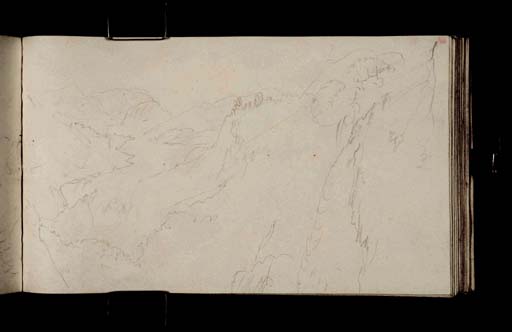Joseph Mallord William Turner Cascata delle Marmore and the Valley of the Nar 1819
Image 1 of 2
Joseph Mallord William Turner,
Cascata delle Marmore and the Valley of the Nar
1819
Joseph Mallord William Turner 1775–1851
Folio 51 Verso:
Cascata delle Marmore and the Valley of the Nar 1819
D14753
Turner Bequest CLXXVII 51 a
Turner Bequest CLXXVII 51 a
Pencil on white wove paper, 110 x 186 mm
Accepted by the nation as part of the Turner Bequest 1856
References
1909
A.J. Finberg, A Complete Inventory of the Drawings of the Turner Bequest, London 1909, vol.I, p.522, as ‘Mountains’.
1984
Cecilia Powell, ‘Turner on Classic Ground: His Visits to Central and Southern Italy and Related Paintings and Drawings’, unpublished Ph.D thesis, Courtauld Institute of Art, University of London 1984, pp. 101, 469 note 143.
1987
Cecilia Powell, Turner in the South: Rome, Naples, Florence, New Haven and London 1987, p.34.
2008
James Hamilton, Nicola Moorby, Christopher Baker and others, Turner e l’Italia, exhibition catalogue, Palazzo dei Diamanti, Ferrara 2008, pp.44, 90 note 29.
2009
James Hamilton, Nicola Moorby, Christopher Baker and others, Turner & Italy, exhibition catalogue, National Galleries of Scotland, Edinburgh 2009, pp.42, 150–1 note 29.
At Terni, Turner made a short detour from his route in order to visit the nearby Falls of Terni, also known as the Cascata or Caduta delle Marmore, an impressive waterfall created by the descent of the River Velino into the valley below. During the eighteenth and nineteenth centuries it represented one of the most popular tourist destinations in Italy outside of Rome. 1 The cascading waters could be viewed from several different locations and in 1781, Pope Pius VI had ordered two small stone huts to be built to facilitate the increasing numbers of visitors to the site. One of these shelters, the Belvedere Inferiore, allowed a vista of the entire spectacle from the bottom, whilst the other, the Belvedere Superiore was situated on a projecting spur of rock, almost level with the brink of the summit. Both could be reached by the road from Terni which diverged at the small village of Papigno. In Turner’s time the Papal Government exercised a monopoly on tourist guides and vehicle hire so that unless visitors were prepared to walk the distance from Terni, they were obliged to pay to access the site.2 For a full discussion of the Falls see folio 55 verso (D14760).
This inverted sketch depicts the view from the hut of Pius VI at the Belvedere Superiore looking across the top of the Falls towards the Valley of the Nar beyond. The town on the slopes of the hill on the left is Ferentillo. The artist has depicted the force of the plunging torrent with a few faint and sketchy lines and blank areas to suggest the white mass of water and mist. Many artists and writers shared Turner’s experience of viewing the waterfall from this ‘shed’, a structure so close to the waters that it was common to become covered in spray.3 John Chetwode Eustace provided a description in A Classical Tour Through Italy:
Here we sat down, and observed the magnificent phenomenon at leisure. At a little distance beyond the cascade, rise two hills of a fine swelling form, covered with groves of ilex. The Velino passes near one of these hills, and suddenly tumbling over a ridge of broken rock, rushes headlong down in one vast sheet, and in three streamlets. The precipice is of brown; its sides are smooth and naked; it forms a semicircle, crowned with wood on the right, and on the left it rises steep, and feathered with evergreens. On the one side, it ascends in broken ridges, and on the other, sinks gradually away, and subsides in a narrow valley, through which the Nar glides gently along till its junction with the Velino4
Similar views can be found on folios 45 verso–46 (D14741–2), 46 verso (D14743) and 50 verso–51 (D14751–2). The viewpoint, and therefore the composition, can also be related to that of a drawing by James Hakewill, Valley of the Nar from the Cascade of Terni circa 1817 (British School in Rome Library).5 Hakewill’s drawing provided the basis for a watercolour by Turner, The Valley of the Nar 1818 (private collection), one of two paintings which were not engraved for use in Hakewill’s Picturesque Tour of Italy.6 Turner also produced a watercolour for the series showing the waterfall from the Belvedere Inferiore, Cascade at Terni (Blackburn Museum and Art Gallery).7
Nicola Moorby
November 2008
Today the waters are diverted for use in a hydroelectric power plant and so the falls are only ‘turned on’ intermittently for the benefit of tourists, see http://www.marmore.it/document.php?id=14 , accessed November 2008.
How to cite
Nicola Moorby, ‘Cascata delle Marmore and the Valley of the Nar 1819 by Joseph Mallord William Turner’, catalogue entry, November 2008, in David Blayney Brown (ed.), J.M.W. Turner: Sketchbooks, Drawings and Watercolours, Tate Research Publication, December 2012, https://www


